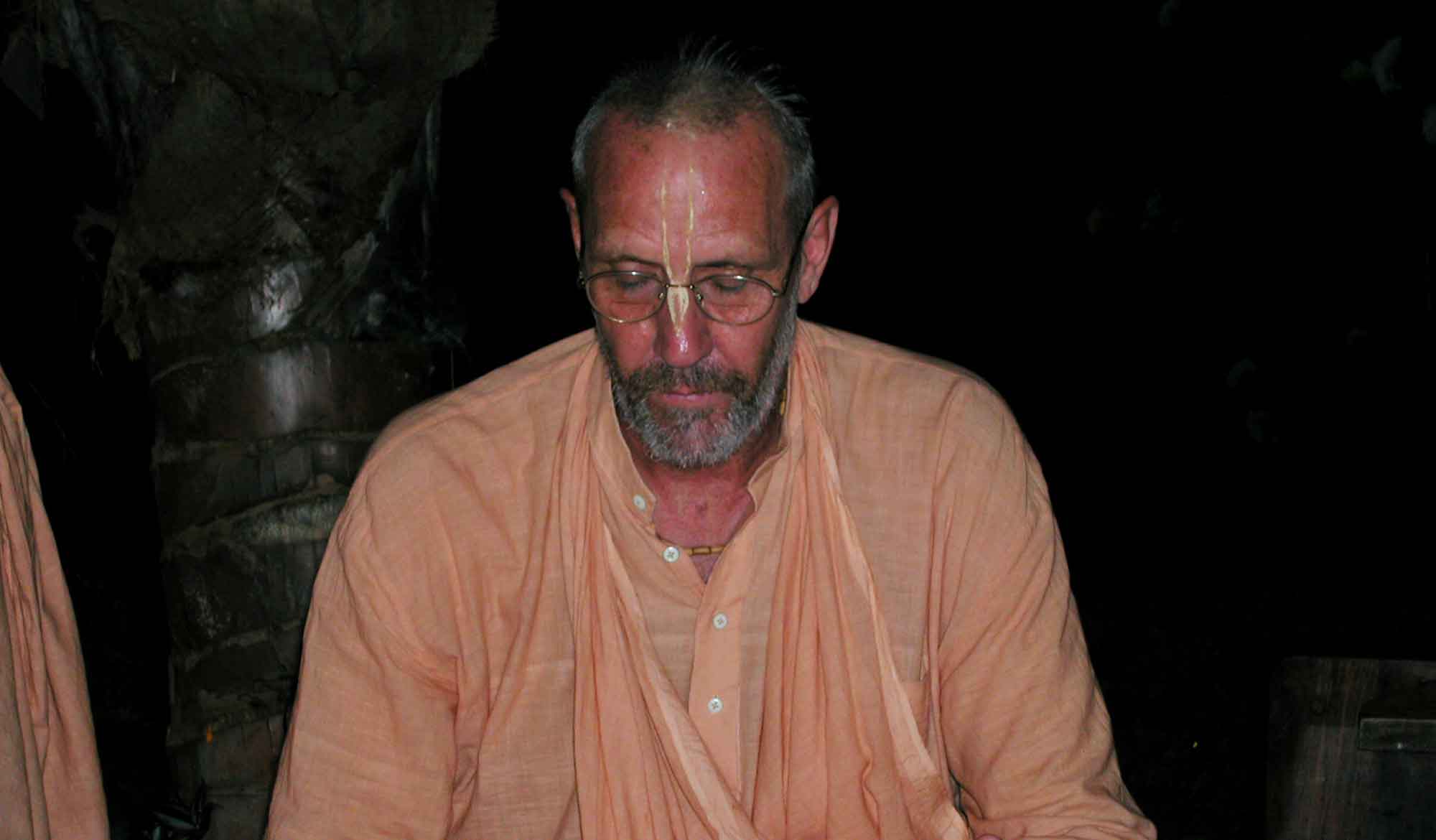by Swami B.G. Narasingha
‘The Literalist’, an article written by Śrīla Narasiṅgha Mahārāja in October 2009, deals with the literal and non-literal interpretation of śāstra, looking at both sides and giving examples from a neutral perspective (taṭasthā vicāra).
A literal understanding of śāstra, as it seems to be regarded in some sections of the greater Vaiṣṇava community, is looked down upon as being neophyte or simply not intellectually satisfying. Some even consider the literal understanding of śāstra to be the great enemy of progressive Kṛṣṇa consciousness – thus we sometimes read such statements as:
“…after the damage devotees have done by literal use of scripture”
or
“…now devotees are blocking the sukṛti of many people in the name of following Śrīla Prabhupāda literally.”
I have not combed the internet or surveyed multitudes of devotees to discover exactly if many feel this way—I have simply come across the above quotes in recent readings and it has sparked a particular thinking in me and the impetus to write this short essay.
Obviously, even the critic of the ‘literalist’ must indeed accept some literal meanings in the śāstra such as in dharma-kṣetre kuru-kṣetre – meaning the place of pilgrimage known as Kurukṣetra (Gītā 1.1). Here a literal reading will take you to a place in North India that many great ācāryas have accepted as the place of the Kurukṣetra War, where Bhagavad-gītā was spoken etc. However, a non-literal reading of the text takes one to the realm of no-Kṛṣṇa and no-Pāṇḍavas. The non-literal interpretation being that Kurukṣetra is the body and the Pāṇḍavas are the senses, etc.
When A.C. Bhaktivedānta Swami Prabhupāda wrote his Gītā translation and commentary he chose Bhagavad-gītā As It Is, for the title –As It Is meaning the literal understanding. He wrote, warning against misinterpretations, “Read Bhagavad-gītā as it is. Then you will be benefited.”
However, Viśvanātha Cakravartī Ṭhākura and Bhaktivinoda Ṭhākura, in their Gītā commentaries, transcend the literal meaning of Bhagavad-gītā and take their reader to a substratum to discover hidden truths. In kind, Śrīla Śrīdhara Mahārāja followed the line of Viśvanātha and Bhaktivinoda and his Gītā commentary is entitled, The Hidden Treasure of the Sweet Absolute.
The revelation of the substratum does not always change the meaning of the literal reading. Indeed, the revelation of the substratum often increases the beauty and charm of the devotee’s experience. It does not necessarily contradict it.
Take the following verse:
sarva-dharmān parityajya mām ekaṁ śaraṇaṁ vraja
ahaṁ tvāṁ sarva-pāpebhyo mokṣayiṣyāmi mā śucaḥ
The literal reading is:
“Abandon all varieties of religion and just surrender unto Me. I shall deliver you from all sinful reactions. Do not fear.” Thus the Lord takes all responsibility for one who surrenders unto Him, and He indemnifies such a person against all reactions of sins. (Bhagavad-gītā As It Is, 18.66)
Revelation of the substratum, however, reads differently:
“Give up all engagements and come to Me. You won’t have to repent, Arjuna, because I am everything to you, and You are everything to Me. This is the most hidden of all hidden truths. What more can I say? And you will find this in Vraja (Goloka Vṛndāvana).” (The Hidden Treasure of the Sweet Absolute, 18.66)
The two readings of Gītā 18.66 are not actually different, but the later gives the devotee a certain solace that a life of surrender leads one to Kṛṣṇa in His supreme abode of Goloka Vṛndāvana.
The substratum or hidden truth of śāstra is sometimes hidden for a purpose – at least one would think so. One thing is said and on occasion a deeper truth is to be understood. It seems to me that the truth is sometimes hidden to keep it out of reach for those who are unqualified — first deserve, then desire.
But herein lies a problem — who is actually qualified to interpret śāstra? Who is actually qualified to understand and enter the substratum? We have often seen how interpretation leads to misinterpretation, especially in the case of the impersonalists and the imitationists. With this consideration in mind one could conclude that the literalist, although meagre in his/her depth of understanding is safe, or at least for the time being.
To suggest that the literalist is somehow in a safer position as opposed to the interpreter of śāstra is not to say that ignorance is bliss, but such may have its merits. If a great Vaiṣṇava personality such as A.C. Bhaktivedānta Swami Prabhupāda was indeed a literalist, as has been suggested, then surely the literal interpretation of śāstra must have some intrinsic value in the ultimate search for truth.
My perception is that when one makes a literal reading of śāstra one is often faced with the unbelievable, the fantastic — that which mind, intelligence, logic and reason struggles to accept or even totally rejects. Is the literal interpretation of śāstra actually blocking or damaging to our progress as some have suggested, or does the literal interpretation call upon something that is greatly beneficial to us? I believe it does. The literal reading of the śāstra calls upon our faith, however meagre (even blind faith), as the basis of our understanding. The literalist has faith in the śāstra and so he/she takes the śāstra at face value. Is that a bad thing?
After all, faith is the only sure way to know Kṛṣṇa, the unknown and unknowable. Knowledge, reason, logic and even our deepest intelligence are unable to capture Kṛṣṇa. Only our deep faith and surrender can do so.
Śrīla Śrīdhara Mahārāja used to tell the story of a dream that he once had wherein he saw that all his knowledge of śāstra had abandoned him. In his dream he was alone and only his faith remained — that which takes us to the lotus feet of Kṛṣṇa, beyond the coverings of the material world.
Those who knew Śrīdhara Mahārāja certainly know that he had a vast knowledge of śāstra. He had deep realizations, that would make many of us faint. Yet he knew and preached that faith alone was our guide in the infinite.
Some may condemn the literalist as a neophyte, but I personally question such condemnation. Rather than condemn the literal interpretation of śāstra, I tend to lean towards a deeper understanding – perceiving it as a building block of faith in the progressive path of Kṛṣṇa consciousness. Those who condemn the literalists may do better to first learn to believe in the “As It Is” stratum – first acquiring a deeper faith in guru, the Vaiṣṇavas and the śāstra before they venture to explore the substratum. Explorer beware! There are tigers in those forests!
When dealing with the higher plane or the deeper substratum, even a little inaccuracy can create great havoc. In such areas the devotee must be very careful not to misinterpret or to offend, because this can completely eliminate one’s progress.
At the end of the day we are not interpreters of śāstra nor are we literalists — we are harmonists. The harmonist sometimes takes the śāstra literally and sometimes not so — endeavouring to penetrate deeper into the world that is Kṛṣṇa’s inner domain.
For the harmonist — faith (śraddhā) is his greatest asset — knowledge and the intellect are but bystanders in the endeavour. Saints are the beacons that guide the faith of the harmonist to the land ruled completely by faith.
So let us give the literalists their due credit for taking their stand on faith and not relying on the intellect. And while being taken into confidence by the saints and shown the beautiful world of Kṛṣṇa’s inner domain, let us not become proud of our small brains and finite knowledge, lest we become harmonists in name only. While endeavouring to see the deeper meaning of śāstra, are we not to go deeper into the meaning of being a literalist also?
More Articles by Swami B.G. Narasingha
The Sacred River Sindhu/Indus
‘The Sacred River Sindhu/Indus’ was posted by Swami B.G. Narasingha on his blog, narasingha.net, on October 2nd, 2011. In this short article, Narasingha Maharaja explains the significance of the River Sindhu and his pilgrimage to it. This article was later expanded into a bigger article called ‘Sindhu River – How India Got Her Name.’
Instructing the Guru
This article “Instructing the Guru” was written in April 2018 by Śrīla Narasingha Mahārāja who answers a question concerning a previous article wherein a Vaiṣṇavī writes a letter to her dīkṣā-guru and explains to him about the importance of śikṣā. In response, a question was raised by a devotee about the etiquette of a disciple instructing her guru.
The Atomic Ray – From Uniform Consciousness to Individual Conscious Units
In “The Atomic Ray - From Uniform Consciousness to Individual Conscious Units” written in 1996 Śrīla Narasiṅgha Mahārāja discusses the constitutional position of the jīva, according to Bhaktivinoda Ṭhākura and Śrī Caitanya-caritāmṛta.













